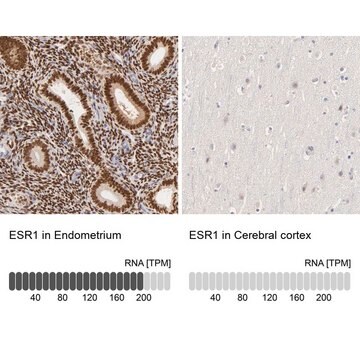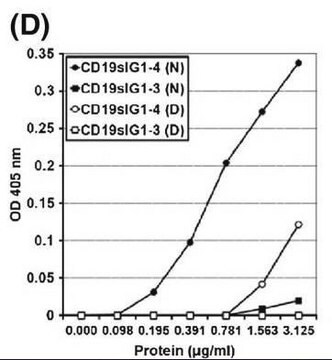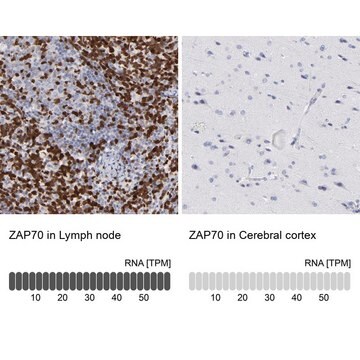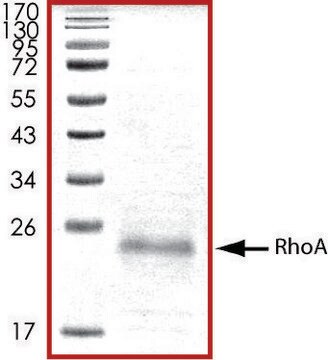추천 제품
생물학적 소스
mouse
Quality Level
항체 형태
purified antibody
항체 생산 유형
primary antibodies
클론
BG8, monoclonal
분자량
calculated mol wt 62.82 kDa
observed mol wt ~62 kDa
정제법
using protein G
종 반응성
mouse
종 반응성(상동성에 의해 예측)
human
포장
antibody small pack of 100 μL
기술
immunocytochemistry: suitable
immunofluorescence: suitable
western blot: suitable
동형
IgG1κ
에피토프 서열
N-terminal
단백질 ID 수납 번호
UniProt 수납 번호
저장 온도
2-8°C
타겟 번역 후 변형
unmodified
유전자 정보
human ... SHC1(6464)
일반 설명
SHC-transforming protein 1 (UniProt: P29353; also known as SHC-transforming protein 3, SHC-transforming protein A, Src homology 2 domain-containing-transforming protein C1, SH2 domain protein C1) is encoded by the SHC1 (also known as SHC, SHCA) gene (Gene ID: 6464) in human. p66Shc is a splice variant of p52Shc/p46Shc with a typical domain organization that is shared by all members of the Shc family of adaptor proteins. It has a phosphotyrosine binding domain, a collagen homology 1 region, and an SH2 domain. p66Shc is shown to be a downstream target of p53 and activated p53 induces its up-regulation by increasing its stability. p66Shc is suggested to be a genetic determinant of aging in mammals as its homozygous deletion is reported to delay senescence and prolong life span in mice. It regulates the mitochondrial pathway of apoptosis by inducing mitochondrial damage after dissociation from an inhibitory protein complex. Under conditions of excessive reactive oxygen species (ROS), p66Shc is phosphorylated on serine 36 by protein kinase C and is targeted to the mitochondrial intermembrane space where it serves as a redox enzyme by oxidizing cytochrome c and reducing oxygen to form ROS. In the absence of p66Shc, release of cytochrome c from mitochondria is impaired and apoptosome can only be activated if purified cytochrome c is supplied. p66Shc induces the collapse of the mitochondrial trans-membrane potential after oxidative stress. p66Shc is also shown to have a neuroprotective role in a murine model of multiple sclerosis. p66Shc knockout (p66-KO) mice develop typical signs of experimental autoimmune encephalomyelitis (EAE). (Ref.: Su, KG., et al. (2012). Eur. J. Neurosci. 35; 562-571; Orsini, F., et al. (2004). J. Biol. Chem. 279(24); 25689-25695).
특이성
Clone BG8 is a mouse monoclonal antibody that detects p66Shc. It was generated in p66Shc-/- mice. It targets an epitope within the N-terminal region.
면역원
GST-tagged recombinant fragment corresponding to the first 110 amino acids from the N-terminal region of human SHC-transforming protein 1 (p66Shc).
애플리케이션
Quality Control Testing
Evaluated by Western Blotting in NIH3T3 cell lysate.
Western Blotting Analysis: A 1:500 dilution of this antibody detected SHC-transforming protein 1 in NIH3T3 cell lysate.
Tested Applications
Immunofluorescence Analysis: A representative lot detected p66shc 1 in Immunofluorescence application (Orsini, F., et al. (2004). J Biol Chem. 279(24): 25689-95).
Immunocytochemistry Analysis: A representative lot detected p66shc in Immunocytochemistry application (Orsini, F., et al. (2004). J Biol Chem. 279(24): 25689-95).
Western Blotting Analysis: A representative lot detected p66shc in Western Blotting application (Orsini, F., et al. (2004). J Biol Chem. 279(24): 25689-95); Su, K.G., et al. (2012). Eur J Neurosci. 35(4):562-71).
Note: Actual optimal working dilutions must be determined by end user as specimens, and experimental conditions may vary with the end user.
Evaluated by Western Blotting in NIH3T3 cell lysate.
Western Blotting Analysis: A 1:500 dilution of this antibody detected SHC-transforming protein 1 in NIH3T3 cell lysate.
Tested Applications
Immunofluorescence Analysis: A representative lot detected p66shc 1 in Immunofluorescence application (Orsini, F., et al. (2004). J Biol Chem. 279(24): 25689-95).
Immunocytochemistry Analysis: A representative lot detected p66shc in Immunocytochemistry application (Orsini, F., et al. (2004). J Biol Chem. 279(24): 25689-95).
Western Blotting Analysis: A representative lot detected p66shc in Western Blotting application (Orsini, F., et al. (2004). J Biol Chem. 279(24): 25689-95); Su, K.G., et al. (2012). Eur J Neurosci. 35(4):562-71).
Note: Actual optimal working dilutions must be determined by end user as specimens, and experimental conditions may vary with the end user.
물리적 형태
Purified mouse monoclonal antibody IgG1 in buffer containing 0.1 M Tris-Glycine (pH 7.4), 150 mM NaCl with 0.05% sodium azide.
재구성
0.5 mg/mL. Please refer to guidance on suggested starting dilutions and/or titers per application and sample type.
저장 및 안정성
Recommended storage: +2°C to +8°C.
기타 정보
Concentration: Please refer to the Certificate of Analysis for the lot-specific concentration.
면책조항
Unless otherwise stated in our catalog or other company documentation accompanying the product(s), our products are intended for research use only and are not to be used for any other purpose, which includes but is not limited to, unauthorized commercial uses, in vitro diagnostic uses, ex vivo or in vivo therapeutic uses or any type of consumption or application to humans or animals.
적합한 제품을 찾을 수 없으신가요?
당사의 제품 선택기 도구.을(를) 시도해 보세요.
Storage Class Code
12 - Non Combustible Liquids
WGK
WGK 1
Flash Point (°F)
Not applicable
Flash Point (°C)
Not applicable
시험 성적서(COA)
제품의 로트/배치 번호를 입력하여 시험 성적서(COA)을 검색하십시오. 로트 및 배치 번호는 제품 라벨에 있는 ‘로트’ 또는 ‘배치’라는 용어 뒤에서 찾을 수 있습니다.
자사의 과학자팀은 생명 과학, 재료 과학, 화학 합성, 크로마토그래피, 분석 및 기타 많은 영역을 포함한 모든 과학 분야에 경험이 있습니다..
고객지원팀으로 연락바랍니다.






